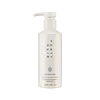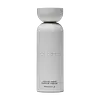What's inside
What's inside
 Key Ingredients
Key Ingredients

 Benefits
Benefits

 Concerns
Concerns

 Ingredients Side-by-side
Ingredients Side-by-side

Water
Skin ConditioningSodium Cocoyl Isethionate
CleansingSodium Lauroyl Methyl Isethionate
CleansingLauryl Glucoside
CleansingDisteareth-75 Ipdi
Propanediol
SolventHydrolyzed Rice Protein
Skin ConditioningHydrolyzed Vegetable Protein
Skin ConditioningPereskia Aculeata Callus Extract
Panthenol
Skin ConditioningCamellia Sinensis Leaf Extract
AntimicrobialAlanine
MaskingArginine
MaskingAspartic Acid
MaskingGlycine
BufferingHistidine
HumectantIsoleucine
Skin ConditioningPhenylalanine
MaskingProline
Skin ConditioningSerine
MaskingThreonine
Valine
MaskingCitric Acid
BufferingPCA
HumectantMomordica Cochinchinensis Seed Extract
Skin ConditioningSodium PCA
HumectantHelianthus Annuus Seed Oil
EmollientLactobacillus Ferment
Skin ConditioningSodium Carrageenan
Emulsion StabilisingGuar Hydroxypropyltrimonium Chloride
Skin ConditioningSodium Lactate
BufferingTetrasodium Glutamate Diacetate
Glycerin
HumectantCaprylyl Glycol
EmollientEthylhexylglycerin
Skin ConditioningPotassium Sorbate
PreservativeSodium Benzoate
MaskingPhenoxyethanol
PreservativeParfum
MaskingBenzyl Salicylate
PerfumingLimonene
PerfumingLinalool
PerfumingWater, Sodium Cocoyl Isethionate, Sodium Lauroyl Methyl Isethionate, Lauryl Glucoside, Disteareth-75 Ipdi, Propanediol, Hydrolyzed Rice Protein, Hydrolyzed Vegetable Protein, Pereskia Aculeata Callus Extract, Panthenol, Camellia Sinensis Leaf Extract, Alanine, Arginine, Aspartic Acid, Glycine, Histidine, Isoleucine, Phenylalanine, Proline, Serine, Threonine, Valine, Citric Acid, PCA, Momordica Cochinchinensis Seed Extract, Sodium PCA, Helianthus Annuus Seed Oil, Lactobacillus Ferment, Sodium Carrageenan, Guar Hydroxypropyltrimonium Chloride, Sodium Lactate, Tetrasodium Glutamate Diacetate, Glycerin, Caprylyl Glycol, Ethylhexylglycerin, Potassium Sorbate, Sodium Benzoate, Phenoxyethanol, Parfum, Benzyl Salicylate, Limonene, Linalool
Water
Skin ConditioningSodium Lauroyl Methyl Isethionate
CleansingGlycerin
HumectantCocamidopropyl Betaine
CleansingPolyquaternium-7
Polyquaternium-10
Glycol Distearate
EmollientHydrolyzed Rice Protein
Skin ConditioningLactobacillus
Skin ConditioningOlea Europaea Fruit Oil
MaskingMoringa Oleifera Seed Oil
EmollientAdansonia Digitata Seed Oil
EmollientNigella Sativa Seed Oil
EmollientArgania Spinosa Kernel Oil
EmollientRosmarinus Officinalis Leaf Oil
MaskingSodium Hyaluronate
HumectantHyssopus Officinalis Extract
MaskingCoco-Glucoside
CleansingGlyceryl Oleate
EmollientGuar Hydroxypropyltrimonium Chloride
Skin ConditioningHydrolyzed Hyaluronic Acid
HumectantEclipta Prostrata Extract
Skin ConditioningHibiscus Rosa-Sinensis Flower Extract
HumectantChlorella Ferment
Skin ConditioningTremella Fuciformis Polysaccharide
Emulsion StabilisingCaramel
Cosmetic ColorantSodium Phytate
1,2-Hexanediol
Skin ConditioningHydroxyethylcellulose
Emulsion StabilisingParfum
MaskingEthylhexylglycerin
Skin ConditioningPhenoxyethanol
PreservativeTrisodium Ethylenediamine Disuccinate
Sodium Benzoate
MaskingSodium Phosphate
BufferingCitric Acid
BufferingTocopherol
AntioxidantHydrogenated Palm Glycerides Citrate
EmollientDisodium Phosphate
BufferingPolysorbate 60
EmulsifyingBenzyl Alcohol
PerfumingPotassium Sorbate
PreservativeLactic Acid
BufferingLinalool
PerfumingWater, Sodium Lauroyl Methyl Isethionate, Glycerin, Cocamidopropyl Betaine, Polyquaternium-7, Polyquaternium-10, Glycol Distearate, Hydrolyzed Rice Protein, Lactobacillus, Olea Europaea Fruit Oil, Moringa Oleifera Seed Oil, Adansonia Digitata Seed Oil, Nigella Sativa Seed Oil, Argania Spinosa Kernel Oil, Rosmarinus Officinalis Leaf Oil, Sodium Hyaluronate, Hyssopus Officinalis Extract, Coco-Glucoside, Glyceryl Oleate, Guar Hydroxypropyltrimonium Chloride, Hydrolyzed Hyaluronic Acid, Eclipta Prostrata Extract, Hibiscus Rosa-Sinensis Flower Extract, Chlorella Ferment, Tremella Fuciformis Polysaccharide, Caramel, Sodium Phytate, 1,2-Hexanediol, Hydroxyethylcellulose, Parfum, Ethylhexylglycerin, Phenoxyethanol, Trisodium Ethylenediamine Disuccinate, Sodium Benzoate, Sodium Phosphate, Citric Acid, Tocopherol, Hydrogenated Palm Glycerides Citrate, Disodium Phosphate, Polysorbate 60, Benzyl Alcohol, Potassium Sorbate, Lactic Acid, Linalool
Ingredients Explained
These ingredients are found in both products.
Ingredients higher up in an ingredient list are typically present in a larger amount.
Citric Acid is an alpha hydroxy acid (AHA) naturally found in citrus fruits like oranges, lemons, and limes.
Like other AHAs, citric acid can exfoliate skin by breaking down the bonds that hold dead skin cells together. This helps reveal smoother and brighter skin underneath.
However, this exfoliating effect only happens at high concentrations (20%) which can be hard to find in cosmetic products.
Due to this, citric acid is usually included in small amounts as a pH adjuster. This helps keep products slightly more acidic and compatible with skin's natural pH.
In skincare formulas, citric acid can:
While it can provide some skin benefits, research shows lactic acid and glycolic acid are generally more effective and less irritating exfoliants.
Most citric acid used in skincare today is made by fermenting sugars (usually from molasses). This synthetic version is identical to the natural citrus form but easier to stabilize and use in formulations.
Read more about some other popular AHA's here:
Learn more about Citric AcidEthylhexylglycerin (we can't pronounce this either) is commonly used as a preservative and skin softener. It is derived from glyceryl.
You might see Ethylhexylglycerin often paired with other preservatives such as phenoxyethanol. Ethylhexylglycerin has been found to increase the effectiveness of these other preservatives.
Glycerin is already naturally found in your skin. It helps moisturize and protect your skin.
A study from 2016 found glycerin to be more effective as a humectant than AHAs and hyaluronic acid.
As a humectant, it helps the skin stay hydrated by pulling moisture to your skin. The low molecular weight of glycerin allows it to pull moisture into the deeper layers of your skin.
Hydrated skin improves your skin barrier; Your skin barrier helps protect against irritants and bacteria.
Glycerin has also been found to have antimicrobial and antiviral properties. Due to these properties, glycerin is often used in wound and burn treatments.
In cosmetics, glycerin is usually derived from plants such as soybean or palm. However, it can also be sourced from animals, such as tallow or animal fat.
This ingredient is organic, colorless, odorless, and non-toxic.
Glycerin is the name for this ingredient in American English. British English uses Glycerol/Glycerine.
Learn more about GlycerinThis ingredient is derived from guar gum.
It is a conditioning ingredient, meaning it helps soften skin and hair.
Hydrolyzed Rice Protein is protein extracted from rice. This ingredient is rich in antioxidants and peptides.
Studies show this ingredient may help with blocking the melanin creation process when skin is exposed to UV.
Linalool is a fragrance and helps add scent to products. It's derived from common plants such as cinnamon, mint, citrus, and lavender.
Like Limonene, this ingredient oxidizes when exposed to air. Oxidized linalool can cause allergies and skin sensitivity.
This ingredient has a scent that is floral, spicy tropical, and citrus-like.
Learn more about LinaloolParfum is a catch-all term for an ingredient or more that is used to give a scent to products.
Also called "fragrance", this ingredient can be a blend of hundreds of chemicals or plant oils. This means every product with "fragrance" or "parfum" in the ingredients list is a different mixture.
For instance, Habanolide is a proprietary trade name for a specific aroma chemical. When used as a fragrance ingredient in cosmetics, most aroma chemicals fall under the broad labeling category of “FRAGRANCE” or “PARFUM” according to EU and US regulations.
The term 'parfum' or 'fragrance' is not regulated in many countries. In many cases, it is up to the brand to define this term.
For instance, many brands choose to label themselves as "fragrance-free" because they are not using synthetic fragrances. However, their products may still contain ingredients such as essential oils that are considered a fragrance by INCI standards.
One example is Calendula flower extract. Calendula is an essential oil that still imparts a scent or 'fragrance'.
Depending on the blend, the ingredients in the mixture can cause allergies and sensitivities on the skin. Some ingredients that are known EU allergens include linalool and citronellol.
Parfum can also be used to mask or cover an unpleasant scent.
The bottom line is: not all fragrances/parfum/ingredients are created equally. If you are worried about fragrances, we recommend taking a closer look at an ingredient. And of course, we always recommend speaking with a professional.
Learn more about ParfumPhenoxyethanol is a preservative that has germicide, antimicrobial, and aromatic properties. Studies show that phenoxyethanol can prevent microbial growth. By itself, it has a scent that is similar to that of a rose.
It's often used in formulations along with Caprylyl Glycol to preserve the shelf life of products.
Potassium Sorbate is a preservative used to prevent yeast and mold in products. It is commonly found in both cosmetic and food products.
This ingredient comes from potassium salt derived from sorbic acid. Sorbic acid is a natural antibiotic and effective against fungus.
Both potassium sorbate and sorbic acid can be found in baked goods, cheeses, dried meats, dried fruit, ice cream, pickles, wine, yogurt, and more.
You'll often find this ingredient used with other preservatives.
Learn more about Potassium SorbateSodium Benzoate is a preservative. It's used in both cosmetic and food products to inhibit the growth of mold and bacteria. It is typically produced synthetically.
Both the US FDA and EU Health Committee have approved the use of sodium benzoate. In the US, levels of 0.1% (of the total product) are allowed.
Sodium benzoate works as a preservative by inhibiting the growth of bacteria inside of cells. It prevents the cell from fermenting a type of sugar using an enzyme called phosphofructokinase.
It is the salt of benzoic acid. Foods containing sodium benzoate include soda, salad dressings, condiments, fruit juices, wines, and snack foods.
Studies for using ascorbic acid and sodium benzoate in cosmetics are lacking, especially in skincare routines with multiple steps.
We always recommend speaking with a professional, such as a dermatologist, if you have any concerns.
Learn more about Sodium BenzoateSodium Lauroyl Methyl Isethionate is a cleansing ingredient. It is a surfactant, meaning it helps gather dirt, oil, and other pollutants. This helps them be rinsed away easily.
Water. It's the most common cosmetic ingredient of all. You'll usually see it at the top of ingredient lists, meaning that it makes up the largest part of the product.
So why is it so popular? Water most often acts as a solvent - this means that it helps dissolve other ingredients into the formulation.
You'll also recognize water as that liquid we all need to stay alive. If you see this, drink a glass of water. Stay hydrated!
Learn more about Water